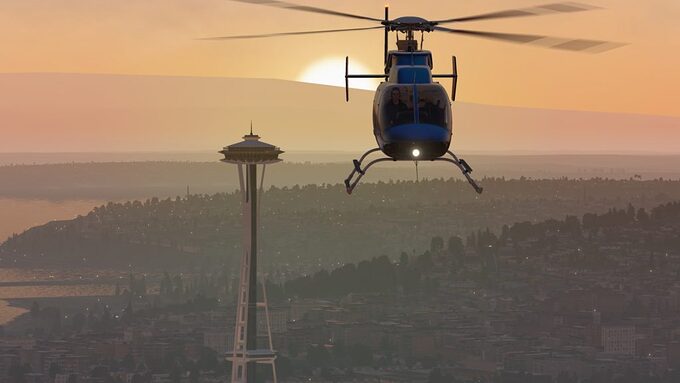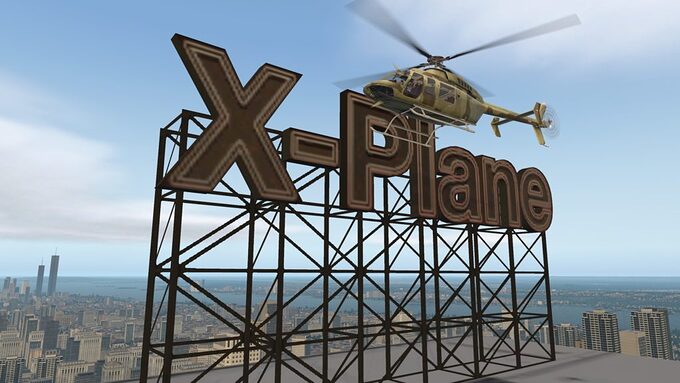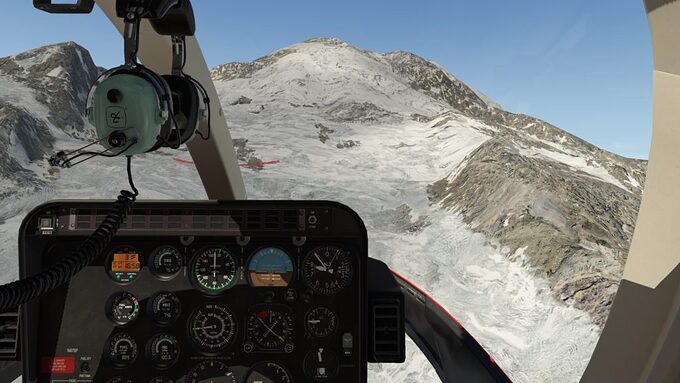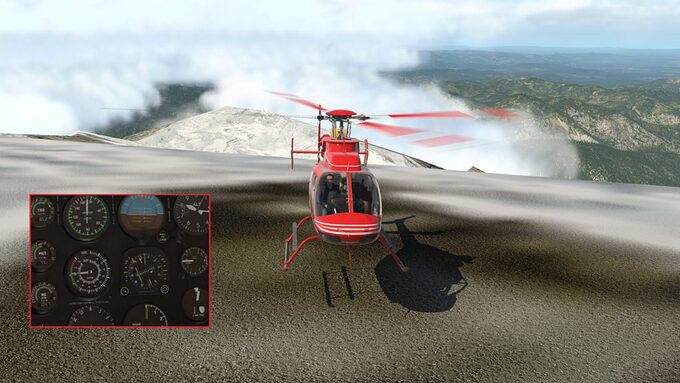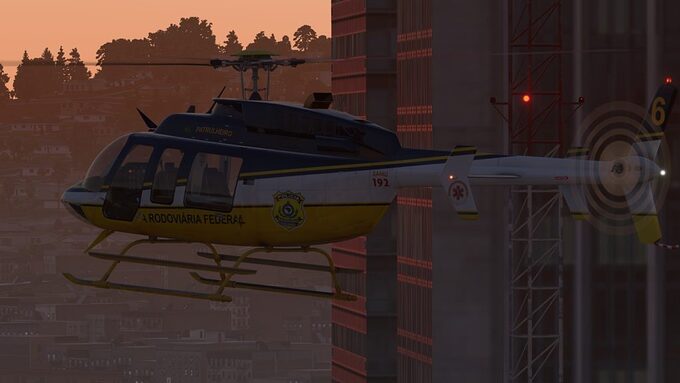DreamFoil Bell 407 Updated for X-Plane 11
By @smokinhole - May 15, 2017
Originally published at: Articles - Mudspike Forums
Guest Contributor Eric “smokinhole” Anderson takes a look at the newly updated DreamFoil Bell 407 for X-Plane 11 and gives us his thoughts and observations about this add-on.
Watch Your Attitude!
$35 for a helicopter that doesn’t blow stuff up when I push the red button? I am way too cheap for that! My cheap nature is reflected in the sad fact that for years now I have struggled to shoehorn an ’09 iMac into a sim hobby that, even at the date of purchase, needed far more horsepower. Until upgrading recently I didn’t appreciate how trying to make that old dog bark was killing my enthusiasm for flight sims. An investment in both time and money has resulted in a long overdue attitude adjustment. Those friends I have left will be surprised to learn that I now truly believe that we live in the best moment in time to have a sim adiction.
Fly It Like You Studied It!
I bought the 407 while out of town immediately after reading the ad. In the past I would have forgotten the purchase the instant after I made it. Now I understand that this hobby–any difficult hobby–is like a marriage: you must work at it. I found a PDF copy of the Bell 407 Flight Manual online and read it cover to cover. Mind you this wasn’t a steep climb because the 407 has, if anything, gotten even more simple to operate since the days of its predecessor, the Jet Ranger. In addition to the studying I made the commitment that, once home, I would do more than just kick the skids and fly. I would put in the time.
Real first flights have been special, rare and sometimes anxious experiences for me. Virtual first flights don’t happen every day either. So I wanted to savor this moment like a fine meal and took the time to enjoy the anticipation. In the past I cared so little about a virtual airplane’s exterior that I never learned the Shift+number keys that X-Plane uses for various camera views. Yet another example of where effort pays off in further appreciation–and how the inverse is also true. The rotors are secured to the skids with tie-downs and the blades pop up with the loss of tension as each line is removed. A similar detail is seen when you click the fuel port and add or remove a substantial amount of fuel: the skids compress or extend an inch or two. ARMA has spoiled me in the way that it’s players are able to interact with an object, inside and outside. I thought I could sit in the back, check the legroom and pretend to smell the leather. But clicking the entry arrow at any open door puts you directly into the right pilot’s seat. Like ARMA, there is a bit of head roll as you shoe-horn your way in. (The first time this happened I recentered my TrackIr several times thinking it had gone awry.)
A Man-Child Plays Pretend
For a couple of paragraphs, I’d like to step away from reviewing DreamFoil’s work and instead use their model as a tool to judge the real thing. This is a bit of a fools game, I know. But I am doing it this way because:
- at 48, it’s still fun to pretend, and
- I have two hours in helicopters, neither of which were turbine powered.
So however I do this, I’m still just a poser. The tiny little modicum of experience I bring to the review leads me to believe that DreamFoil has put together a very convincing package. It looks stunning and sounds spectacular. Let’s just pretend it’s real.
Startup/warmup takes just a couple of minutes even if you do all the appropriate checks. A fixed wing comparison might be something like a Cessna 172. In fact, it is this “172” analogy (which I have heard before about the Jet Ranger) that prepared me to not expect much. Stable, dated, dull. Yes, by light helicopter standards it is pretty stable. And compared to Fenestron and NOTAR equipped competing machines I think it is fair to call it dated. It is a mistake to call it dull. Digital stability with basic autopilot functions (offered after-market for $120,000 as “HeliSAS”) is an option but unless you are planning a long flight, SAS both increases workload and interferes with this helicopter’s otherwise excellent handling. Hover requires attention but is largely predictable even in wind conditions that are not. At close to max gross at sea level on a standard day, an IGE (in ground effect) hover only needs about 65%-75% torque. You can accelerate out of the height-velocity curve and into a 1000 FPM climb while barely pulling more pitch than was needed in the hover. Pull to 90% and you will either push the VSI peg well past the 2000 FPM limit or you will comfortably accelerate to a speed approaching Vne. If the Huey is fun, then the 407 is a screamer. The four blades make a gorgeous racket that implies something bigger and more substantial than is really there. And here’s where the love begins: Roll into a turn or pull into a climb and listen to that rotor system under a load. If the smooth, deep rumble doesn’t earn a smile, nothing will.
At speed the 407 is sensitive yet not twitchy. If correct, this must be a very hard control balance to achieve. Not intended for long flights, the 407 is a VFR workhorse flown single-pilot – often over many hops in a day. It needs to be predictable, not fatiguing. Starting to sound a little DULL isn’t it? You just have to fly it. Bell threaded the needle right where it needed to be between enjoyable, if not thrilling, and safe. Were I to have a complaint, it is that visibility is pretty low when doing quick stops and pinnacle approaches. Even in a simple hover the left-aft-low attitude puts the panel in an excessively large swath of your view. I found rooftop landings easier if I leaned a little to the right to get a better view out the chin. This one gripe is bordering on picky. To forget it, find an undulating road with sweeping curves and (hopefully) free of power lines and hug it low and fast. Zoom past one of Austin Meyer’s police cars. If the FAA isn’t on the pad to greet you when you release the rotor brake, you will look back at that flight as a highlight in your flying career.
Please Pardon My Gas Producer!
Now let us step away from the Lego mess I just made and return to the model as written by DreamFoil and MilViz. Since I am unable to write intelligently about the accuracy of the flying qualities of DreamFoil’s 407 I thought it might be fun to pick a few charts from the Flight Manual and see how the model matches the book.
The most important chart for a single-engine helicopter is the Height Velocity (HV) Diagram. But abiding by the HV curve only matters to the virtual pilot if he wants fly his helicopter in a way that won’t eventually kill his virtual self. Otherwise, it provides no performance information that is useful in making an analysis of real vs fake. So I am picking five which do (Google “Bell 407 Flight Manual pdf” to follow along): Hover In Ground Effect (IGE), Hover Out of Ground Effect (OGE), Rate of Climb, Autorotation Glide Distance, and Power Assurance Check. Actually those are practically all the charts to be found in Performance Section of the manual. What gives the section bulk are the different combinations of power, weight and operating equipment available for each chart so let’s stay consistent with the following criteria:
- Max internal Gross Weight of 5000 pounds
- Standard temperature (ISA)
- Anti-Icing off
- Heater off
- Basic inlet
The area around Mt. Rainier south of Seattle was a suitable spot to use for the high altitude hover checks and Swanson Airport (2W3) seemed a good place to start. During the climb up Rainier I ran a Power Assurance Check at 3000′ MSL. At 708 C MGT (Measured Gas Temp.) torque was 79.5%. The book promised 87% at that temperature or conversely 670 C at my torque. So the Rolls Royce in DreamFoil’s helicopter is not quite pulling its weight. Things improved at 6000 feet where I compared Rate of Climb at a low takeoff power setting of 93% torque and 769 C MGT. This setting and a steady 60 KIAS matched the book at 1600 FPM. Going back to the Power Assurance Check, that torque setting should have cost about 740 C MGT. Nowhere in the manual is it suggested that Gas Producer RPM (NG) will ever normally be a limiting metric. But from 6000′ up I kept exceeding its limit of 105% before hitting anywhere close to a torque or temperature limit. If I honored the limit (and its lovely aural warning) I could only manage a power setting quite shy of the book power setting. Going beyond 106% for more than a few seconds consistently resulted in some mountain autorotation practice. (Of the three I did, I am convinced that one may have been survivable!).
Now to test Hover OGE and Hover IGE. Real or not, I was unable to do a reliable test at Takeoff Power because of the NG limit. So instead I had to settle for max continuous power. Even then I’d get regular aural NG limit beeps. The charts stated that an OGE hover is doable at around 7000 feet and that is pretty much what I got. I tried 8000 feet but sank gently at 200 FPM. In ground effect, the charts predicted a safe hover at around 9000′ MSL and a skid height of 4 feet. The best I could manage was 8200′. At this altitude the NG gauge was cutting me a little slack so I cheated the temperature a little to keep the hover stable while pulling as much as 770 C MGT (Max Continuous is 727 C). Of course stirring the cyclic can significantly affect hover performance and maybe sloppy flying alone can account for my struggle at matching the charts. The 5-minute Takeoff Power setting, had it been possible, would have yielded hover altitudes roughly 3000 feet higher both in and out of ground effect.
The last test is the Autorotation Glide Distance. This one was tough. As far as performance goes, DreamFoil matched the book perfectly. You can check the chart or you can just do some monkey math: Divide altitude (in feet) by 1000 and again by two. So 4000′ gets you two miles. (Hey, that’s about how well my Pitts glides!). I measured where my skids (or carcass) came to rest on runway 34R in Seattle and it was nuts on. The problem I was having was how to manage a minuscule storehouse of rotor inertia. If I tried to level the skids for touchdown there just wasn’t nearly enough umph to cushion the crash. The best I was able to manage was to fly most of the descent at 80 knots (best glide) and at about 500 feet slow to 55 knots (min sink) while keeping the RPM on the high side of the limit with collective. With lots of luck this resulted in a tail-low run-on landing at about 30 knots. Take a couple thousand pounds off and it gets considerably easier. You just might both walk away from the landing and be able to sell the chopper for something more than scrap afterwards. And if you don’t? Blame the color! Choose pink next time and have fun.
Maybe there is a little placebo here but I don’t think I have flown a helicopter where the skids interact with the surface in such a convincing way. The yaw as you pull collective for liftoft is kept light and predictable by friction with the ground. With practice you can easily control drift as the skids get light. And if you relax enough of the correction at liftoff you will be rewarded with a perfectly stable hover. If I have a gripe with DreamFoil’s work on the 407 it is in the way they have incorporated SAS. Turning it on in flight usually isn’t too dramatic but things can get a little crazy turning it off. Deselecting SAS imediately returns the cyclic to wherever it was trimmed when SAS was originally engaged. If the difference between the two stick positions is big enough, loss of control will result. Use SAS as intended: from start to shutdown or don’t use it at all. If it is just added stability you seek, use the Stability Augmentation settings within X-Plane’s own joystick options.
See How She Shines!
DreamFoil’s 407 is not going to toast T-72s from behind a hill. It isn’t going to sling load a medical tent to Everest base camp. But it is as impressive a visual and functional model as I think you will find in X-Plane. That a Jet Ranger variant is still the standard-setting light turbine helicopter after all these years is a good reason to put in the time to learn a little about it. If I can express my satisfaction with this helicopter, it might be best to admit the following: Nearly every shutdown I have made thus far has ended with me Shift+4-ing outside to secure the tie-downs and covers and to appreciate how the moonlight and stars reflect on that deep, glossy finish as she cools quietly on the ramp. This being being the musings of a middle-aged man, my wife might call that pathetic. Sim addicts will call it love.
The DreamFoil Bell 407 is available for purchase at the X-Plane.ORG store for a suggested price of $35.00 US.
Written by Guest Contributor Eric “smokinhole” Anderson – our thanks for this fantastic review!


